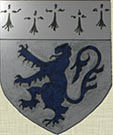 |
SKELTON - IN - CLEVELAND
IN HISTORY
|
 |
"WE WILL REMEMBER THEM"
39255 L/Cpl CHARLES HENRY MOTT.
9th Battalion, Yorkshire Regiment.
Died of wounds, aged 20, on the 15th October 1917.
Born at North Skelton. Enlisted at Brotton, N Yorks.
Son of John and Ada Mott, of 30 William St, North Skelton, N Yorks.
|

Lijssenthoek Military Cemetery, Poperinge, Belgium.
|
FAMILY:-
1901, Charles, aged 3, was living at 30 William St and had been born in N Skelton.
His father, John, aged 34, worked as a Ram Rider in the Ironstone Mine. He had been born in Sunningwell, Berks.
His mother, Ada, aged 24, had been born in Loftus, N Yorks. By the 1911 census she has had 4 children and all are living.
He had 2 sisters - Ethel 4 and Lilly 1. Another girl is listed Beatrice, aged 10,
1911. The family are still at 30 William St. The father is now a Deputy in the Ironstone Mine.
Another daughter has arrived, Minnie, age 1.
|
 |
WAR SITUATION.
The 9th (Service) Battalion, Yorkshire Regiment was Formed at Richmond, 22 September 1914.
It was attached to 69th Brigade, 23rd Division and took part in most of the action on the Western Front.
Prior to 1917 it had been involved in the Battles of the Somme in France.
Charles's Medal Card shows that he did not join his Battalion in France until 1916 or later and it is not known if he was involved in any action prior to his death in October 1917.
He must have been badly wounded in the later stages of the Third Battle of Ypres and taken back to Lijssenthoek casualty station, where he died.
An offensive was mounted by Commonwealth forces at Ypres to divert German attention from a weakened French front further south.
The initial attempt in June to dislodge the Germans from the Messines Ridge was a complete success.
The Infantry attacked on the 31st July after a 2 week Artillery bombardment, which gave the Germans warning and destroyed the drainage of what was to start with a swampy plain.
One of the wettest Summers on record then turned the battleground into pits of mud in which men and horses drowned.
The campaign finally came to a close in November with the capture of Passchendaele.
The 5 mile advance over 3 months had cost 325,000 Allied casualties and a quarter of a million Germans.
|
MEMORIAL:-
The village of Lijssenthoek stood on the main communication line between the Allied military bases in the rear
and the Ypres battlefields.
It was fairly close to the front but out of reach of most of the German Artillery.
Its relative safety made it an ideal place for casualty clearing statons and the cemetery there was used from June 1915.
|
|